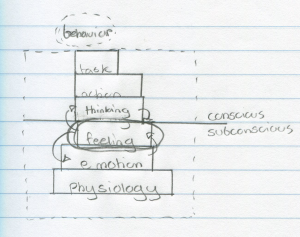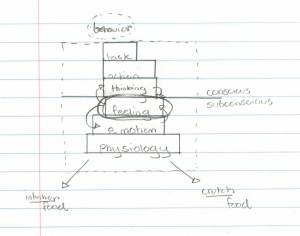Week 2
The hundred pages I covered this week in Gordon M. Shepherd’s book was comically informative. I took four quotes from the text to outline my mode of thinking throughout the first two sections of the book. The first quote,
“The reason for this [olfactory pathway probably being the most heavily modified pathway in the brain] appears to be that our perception of food smells is heavily dependent on our behavioral state: whether we are hungry or full, angry or sad, craving for something or repulsed by it, suspicious of a new food or eager for novelty. The smell image has to be modified by the behavioral state.” (Shepherd 2014: 98)
follows Shepherd’s description of the constant modification of the olfactory pathway relative to other modified pathways in the brain.  This quote instantly reminded me of Dr. Alan Watkin’s presentation of how to sustain a high level of thinking through the depiction of how our physiology affects our thinking. This depiction shows how our physiology sends various electromagnetic signals from our body’s organs to our brain (understood by scientists as emotion, or energy in motion) and how that is consciously understood by us as thinking about how we feel. Emotion is interconnected with feeling just like feeling is interconnected with thinking. The capacity of our body to perform an action towards a desired task is reflected in our behavior. Our behavior can be described as a symptom of our human condition.
This quote instantly reminded me of Dr. Alan Watkin’s presentation of how to sustain a high level of thinking through the depiction of how our physiology affects our thinking. This depiction shows how our physiology sends various electromagnetic signals from our body’s organs to our brain (understood by scientists as emotion, or energy in motion) and how that is consciously understood by us as thinking about how we feel. Emotion is interconnected with feeling just like feeling is interconnected with thinking. The capacity of our body to perform an action towards a desired task is reflected in our behavior. Our behavior can be described as a symptom of our human condition.
The following depiction of Dr. Alan Watkin’s presentation includes my input of intuitively processing emotion and satisfying the “need” to process emotion with a crutch. Food can help alleviate a need to process emotion by reducing physiological stress. “Food” such as chemically engineered flavor packets or other chemically induced fast foods can also be used as a direct means to satisfy a temporary need by providing immediate stimulus at the cost of a food hangover of sorts. If the smell image has to be modified by behavior, which exists as a symptom of human functionality, shouldn’t the emphasis on eating be placed on why not what?
emotion by reducing physiological stress. “Food” such as chemically engineered flavor packets or other chemically induced fast foods can also be used as a direct means to satisfy a temporary need by providing immediate stimulus at the cost of a food hangover of sorts. If the smell image has to be modified by behavior, which exists as a symptom of human functionality, shouldn’t the emphasis on eating be placed on why not what?
The second quote,
“In the same way, [comparing smell and color] we postulate that our smell world would also be only a smear of shades of inchoate sensations set up in our noses if we did not have the circuits in our smell pathway that select specific types of molecule stimulated activity to give them a quality we can identify as distinct from all the rest.” (Shepherd 2014: 87)
describes how the brain perceives molecular stimulated activity in our smell pathway by creating a quality to identify a distinction between other smells. Relating this to the first quote, if a person’s environment supports their behavior and does not support or provide an emphasis on the importance of distinguishing quality to identify certain behaviors as distinct from the rest, then the smell world is but a smear of shades of inchoate sensations. The nose knows.
In the next quote Shepherd describes the exact physiological processes that enable the system to improve its ability to understand input patterns to allow for an increased ability to discriminate between more similar smell molecules.
“This system [interactions between the olfactory cortex and olfactory bulb] learns. The basic cortical circuit has the ability to improve its performance with repeated exposure to different smells. The recurrent excitation strengthens the cells activated by input from the olfactory bulb. The lateral inhibition enhances the contrast between activated and less activated cells. Finally, the synaptic strengths change so that the system can store these changes as a memory and match them to the input. These changes with learning enable the system to improve its ability to match an input pattern to a stored pattern, so that finer discrimination between more similar smell molecules can occur” (Shepherd 2014: 103)
The quote mentions the basic cortical circuit has the ability to improve its performance with repeated exposure to different smells. This increased perspective can help enable the system to improve its ability to match an input pattern to a stored pattern. If different smells are hidden from a young nose, and the young learning system is enabled to match an input pattern to an existing stored pattern this only allows for reinforcement of the same smells. If an individual’s environment promotes an emphasis on what to eat rather than how to eat then the olfactory pathway’s storing of the smell as a memory after the odor image is affected by behavior might be affected if the person’s perception of their behavior is not entirely honest. So let’s be honest, if your behavior stinks would you want to smell it?
“The olfactory cortex microcircuit functions to take an input reflecting many diverse stimuli and construct out of it a coherent odor object. This is an analogy with how the visual system takes an input of different shapes and sizes and constructs a “visual image”. An important aspect of such an object is that seeing only a small part of it still enables the system to “fill in” the missing parts.” (Shepherd 2014: 103)
The ability in the olfactory cortex microcircuit to recognize patterns allows for the system to complete an incomplete image even if only a small part of the incomplete image is available. If our perception of food smells are heavily dependent on our behavioral state, and there is a strong sense of need to satisfy emotion, couldn’t that influence how we seek to satisfy our need to eat food? Over time couldn’t that influence how we learn to smell? Over time couldn’t that influence how we learn to “fill in” the missing parts? If it becomes a part of our behavior, wouldn’t it be easier to change the perception of the behavior itself?
Food creates culture.
Flavor is our perception.
Quit tasting.
Smell.

Leave a Reply